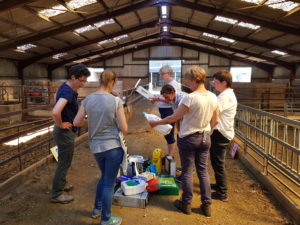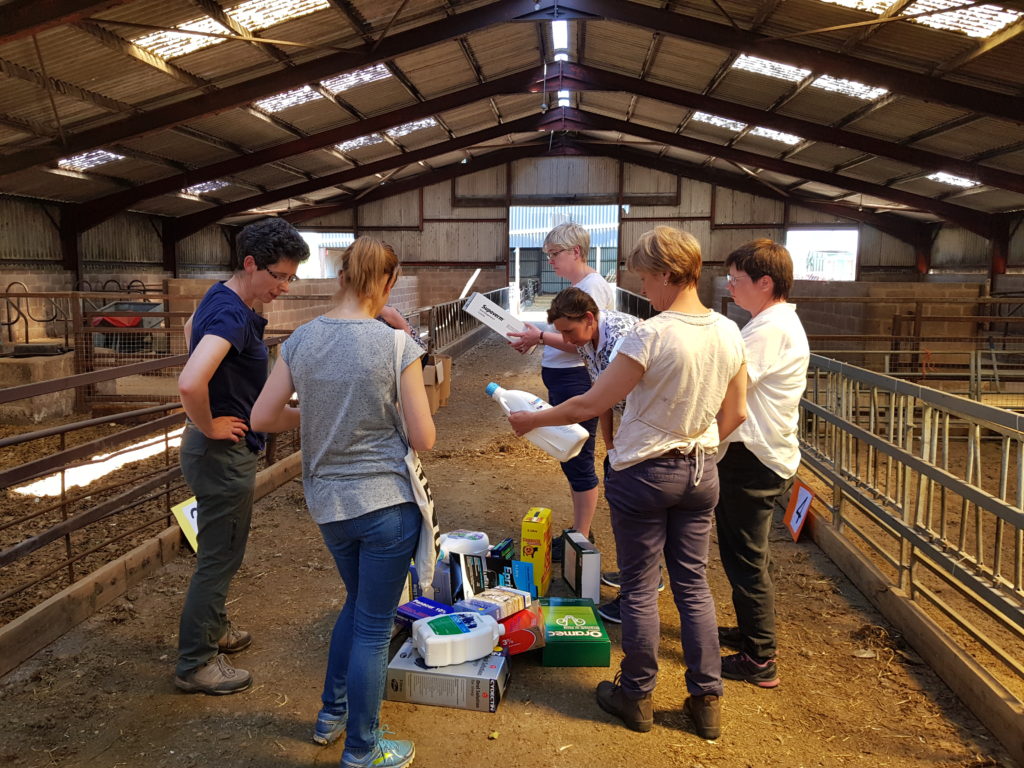Women in agriculture: Lanarkshire – Post-event summary
28 June 2018Key Points:
- EID recording of sheep can be used to improve business efficiency and inform management decisions.
- Ensure all sections (continuous, identification and replacement records) of your holding register are complete.
- Complete all fields of SAMU document (including vehicle registration)
- Information provided from CCP’ (markets) cannot always be relied on due to poor read rates. It is your responsibility to ensure your holding register is correct.
- Check that the wormer you are using is working by dung sampling. Lambs in late summer/autumn is often the best time to do this.
- Start using Zolvix and Startect (group 4 and 5 wormers) as a quarantine dose and/or a strategic late season lamb dose as part of a resistance strategy.
- Think about what is on the grass i.e. low or high risk grazing. Try and create some low risk grazing, especially for lambs after weaning.
Introduction
The hot weather (30oC) lead to a rather depleted turnout to the second women in agriculture meeting as many people were busy with shearing or silage. The meeting was held at Carstairs Mains, by kind permission of Andrew Baillie. Speakers for the day were Hazel Laughton SAC Consultant and Heather Stevenson SAC Vet.
Summary
Hazel Laughton covered sheep recording topics including statutory requirements and the benefits of EID recording. (Do’s and Don’ts of sheep recording attached). Hazel’s covered some of the common tagging and recording errors
- Animals over 12 months with slaughter tags in
- No red tags on farm or none recorded
- Sheep with no tags
- Sheep not on holding of birth without like for like or red tags when replaced
- SAMU documents not completed (i.e. no haulage details)
Andrew Baillie gave an overview of his system including running sheep through his automatic weigh crate and drafter. Andrew has been performance recording his pedigree flock for around 5 years but has upgraded to full EID recording of all sheep on the farm in the past 2 years. All lambs are tagged at birth and all treatments and handling activities are recorded on the EID reader which links to his sheep records. The system has already saved him a lot of time by updating his statutory records as he goes. He is also able to record comments against sheep throughout the year which can help him inform breeding decisions later in the year. Andrew also showed the group his automatic dosing gun which is linked to the weigh head on the race. This allows all sheep to be accurately dosed by weight which gives him more confidence that no sheep are being over or under dosed. Andrew also has all his cattle EID tagged and uses the same system to record births, movements and treatments.
Heather Stevenson gave a very informative talk on worm control in sheep using practical methods to explain worming groups, animal and pasture contamination, drug/worm resistance and the effects of the dosing gun not being properly calibrated. Whilst Heather explained these topics in great detail, the messages at the end were very simple.
All 52 wormers on the UK market belong to 5 medicine groups – 1-BZ, 2-LV, 3-ML, 4-AD, and 5-SI. These groups are displayed on the package and it is important to understand and pay attention to which group the products you use belong to. It is good practice to rotate between different groups to minimise resistance. Resistance is prevalent in groups 1-3 and has now been reported in England in group 4 wormers. Remember that the cheapest isn’t always the best option, group 1 contains the cheapest products but it has reported resistance on many farms throughout Scotland. 
Faecal egg counts should be used to assess the requirement for worming and dosing guns should always be correctly calibrated to ensure that sheep are receiving the correct dosage- under dosing can speed up resistance in your flock.
Quarantine dosing of purchased stock (including tups) should be carried out in all cases. Purchased sheep should be dosed with a group 4 or 5 wormers and housed for 24-48 hours to avoid shedding any worms eggs onto pasture.
It is vital to look at pasture contamination in addition to treatments used. If pastures are infected with worms resistant to a worming group it can take a very long time to reverse this if at all, thus severely limiting treatment options. It is good practice to discuss worming regimes and products with your local vet.
If anyone would like more information or assistance on any of the topics covered please do not hesitate to contact Jennifer or Hazel. Heather Stevenson may also be contacted and her details can be supplied upon request. Handouts and information from the meeting and on other topics are available below
Future Events
Next Meeting – Thursday 1st November (venue and time TBC) Details will be available at FAS.Scot in due course.
Useful Contacts
SAC Consulting Facilitators: Jennifer Brown Tel: 01555 662562 jennifer.brown@sac.co.uk
Useful Web Addresses: SGRPID: www.scotland.gov.uk
- Sheep Record Keeping Do’s and Don’ts
- Topics: Livestock
Sign up to the FAS newsletter
Receive updates on news, events and publications from Scotland’s Farm Advisory Service

